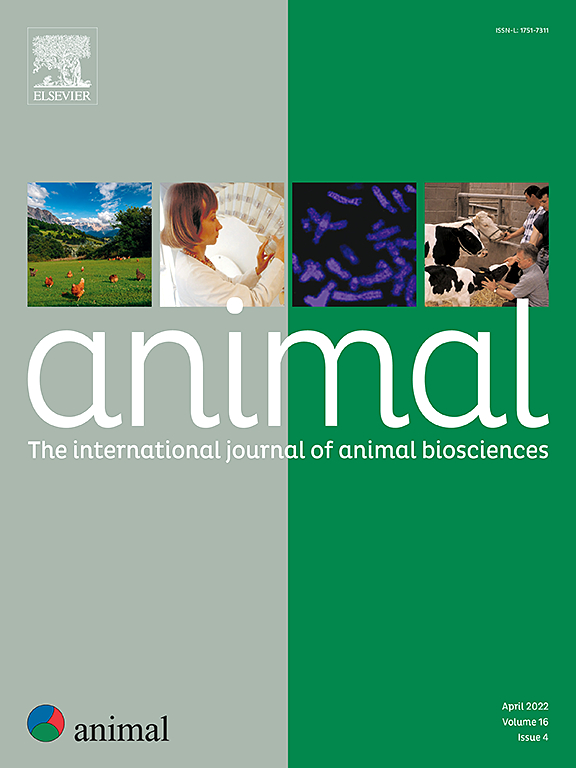Pigs exposed to nitrogen, argon or carbon dioxide filled high-expansion foam: behavioural responses, stun process and blood lactate concentration
IF 4
2区 农林科学
Q1 AGRICULTURE, DAIRY & ANIMAL SCIENCE
引用次数: 0
Abstract
According to the EU legislation, all animals farmed for food production must be stunned before being exsanguinated (exempt slaughter prescribed by religious rites). Stunning methods must be reliable, effective, and free from avoidable pain, distress, and suffering, warranting continuous improvement. New methods must be thoroughly evaluated from an animal welfare perspective before approval. One technology developed for on-farm euthanasia and large-scale depopulation for disease control in pigs uses high-expansion foam to create an anoxic atmosphere in a closed container. The method has previously been suggested as a potential method for stunning pigs at slaughter. This study compared the behavioural responses and stun process (e.g., loss of posture and convulsions) of pigs exposed to three different gases (N2, Ar, and CO2) delivered in high-expansion foam. Thirty-six pigs, approximately 12 weeks old, were placed one at a time in a container and exposed to either N2, Ar, or CO2 gas-filled foam for 5 min from foam start. Behavioural observations were conducted from video recordings, assessing time to loss of balance, loss of posture, last strong convulsion and last muscle contraction. Results showed that pigs in the CO2 treatment performed escape attempts significantly earlier than in N2 and Ar, and there were more pigs that performed this behaviour in CO2, indicating that high concentrations of CO2 are more aversive than Ar and N2. Pigs exposed to CO2 foam also avoided the foam earlier compared to the other two gases. Loss of posture occurred earlier in the CO2 treatment, consistent with the anaesthetic effect of CO2. A faster foam filling time for CO2 foam may be a contributing factor to the differences found; however, filling time was adjusted for in the statistical analyses to reduce bias in the comparisons between gases. All pigs across treatments were adequately stunned after 5 min, with no corneal reflex, rhythmic breathing, gagging, or muscle contractions upon removal from the container. No indications of regained consciousness during sticking and bleeding were found. In conclusion, the gas foam method was effective in stunning the pigs regardless of the gas type used. The less aversive responses to Ar and N2 foam are positive from an animal welfare perspective, but the longer time to loss of consciousness compared to CO2 is a disadvantage.
猪暴露于氮气,氩气或二氧化碳填充的高膨胀泡沫:行为反应,昏迷过程和血乳酸浓度
根据欧盟立法,所有用于食品生产的动物在被放血前必须被击昏(宗教仪式规定的豁免屠杀)。惊人的方法必须是可靠的,有效的,没有可避免的痛苦,困扰和痛苦,保证持续改进。在批准之前,必须从动物福利的角度对新方法进行彻底的评估。一项用于农场安乐死和大规模减少猪群以控制疾病的技术是使用高膨胀泡沫在封闭容器中创造缺氧环境。这种方法以前曾被建议作为一种潜在的在屠宰时使猪昏迷的方法。本研究比较了暴露于高膨胀泡沫中三种不同气体(N2、Ar和CO2)的猪的行为反应和昏迷过程(例如,失去姿势和抽搐)。将36头约12周龄的猪一次一只放入容器中,从泡沫开始开始,将其暴露于N2、Ar或CO2填充的泡沫中5分钟。通过录像进行行为观察,评估失去平衡、失去姿势、最后一次强烈抽搐和最后一次肌肉收缩的时间。结果表明,在CO2处理下的猪比在N2和Ar处理下的猪更早地进行了逃跑尝试,并且在CO2处理下有更多的猪进行了这种行为,这表明高浓度CO2比Ar和N2更令人厌恶。与其他两种气体相比,接触二氧化碳泡沫的猪也更早地避开了泡沫。在CO2治疗中,姿势的丧失发生得较早,这与CO2的麻醉作用一致。CO2泡沫更快的填充时间可能是造成差异的一个因素;但是,在统计分析中对加注时间进行了调整,以减少气体之间比较的偏差。所有处理的猪在5分钟后充分昏迷,从容器中取出后没有角膜反射,有节奏的呼吸,呕吐或肌肉收缩。没有迹象表明在粘连和出血过程中恢复意识。综上所述,无论使用何种气体,气体泡沫法均能有效地使猪昏迷。从动物福利的角度来看,对Ar和N2泡沫的不良反应较少是积极的,但与二氧化碳相比,较长的意识丧失时间是一个缺点。
本文章由计算机程序翻译,如有差异,请以英文原文为准。
求助全文
约1分钟内获得全文
求助全文
来源期刊

Animal
农林科学-奶制品与动物科学
CiteScore
7.50
自引率
2.80%
发文量
246
审稿时长
3 months
期刊介绍:
Editorial board
animal attracts the best research in animal biology and animal systems from across the spectrum of the agricultural, biomedical, and environmental sciences. It is the central element in an exciting collaboration between the British Society of Animal Science (BSAS), Institut National de la Recherche Agronomique (INRA) and the European Federation of Animal Science (EAAP) and represents a merging of three scientific journals: Animal Science; Animal Research; Reproduction, Nutrition, Development. animal publishes original cutting-edge research, ''hot'' topics and horizon-scanning reviews on animal-related aspects of the life sciences at the molecular, cellular, organ, whole animal and production system levels. The main subject areas include: breeding and genetics; nutrition; physiology and functional biology of systems; behaviour, health and welfare; farming systems, environmental impact and climate change; product quality, human health and well-being. Animal models and papers dealing with the integration of research between these topics and their impact on the environment and people are particularly welcome.
 求助内容:
求助内容: 应助结果提醒方式:
应助结果提醒方式:


